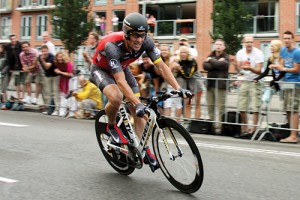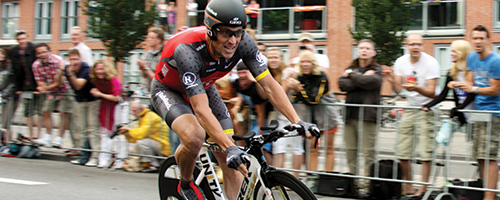Over the past four months, the myth of Lance Armstrong has been carefully and systematically dismantled to expose only the unfortunate facts lying beneath. Armstrong, winner of an unprecedented seven straight Tour de France titles from 1999–2005, has been stripped of all competitive results since 1998 by the United States Anti-Doping Agency and will now begin serving a lifetime ban from any event over which the organization presides.
Fall of an icon, end of an era
Over the past four months, the myth of Lance Armstrong has been carefully and systematically dismantled to expose only the unfortunate facts lying beneath. Armstrong, winner of an unprecedented seven straight Tour de France titles from 1999–2005, has been stripped of all competitive results since 1998 by the United States Anti-Doping Agency and will now begin serving a lifetime ban from any event over which the organization presides.

COURTESY OF pbelskamp
Blacklisted: Lance Armstrong, the most decorated cyclist in history, has been banned for life from official competition by the USADA. Formerly among the most beloved athletes in the world, Armstrong is now widely reviled for his role in an extensive doping scandel during his career.
The testimony presented by the USADA’s 202-page “Reasoned Decision” was thorough—and thoroughly damning. The evidence compiled in the investigation, which for years was never able to make it past the “serious allegations” stage, overwhelmingly points to Armstrong’s guilt as the kingpin of a comprehensive doping program while in the ranks of the U.S. Postal Service and Discovery Channel cycling teams. After fresh charges were brought forth in August and Armstrong declined to contest them, the USADA went forward with its judgment, and the overthrow of the icon was finally complete.
The story of Lance
Armstrong—cancer survivor, founder of the Livestrong Foundation, inspiration to millions and now disgraced champion—is certainly a tragic one, but only the details are unique. The motivation to gain a pharmaceutically assisted advantage is deeply ingrained in the history of modern sports. It has only intensified over the years, and the nagging ethical dilemma among spectators as to what is legitimate and what is illicit is becoming more complex with each new scandal.
The Amaury Sport Organisation, the group in charge of coordinating the annual Tour de France competition, has said that it will not retroactively award winners to replace Armstrong in the record books. In truth, it would have a tough time determining a clean winner even if it wanted to. Nearly everyone who stood on the podium with Armstrong in Paris during that seven-year run has either served a doping ban since then, been incriminated in the ongoing investigations or admitted to drug use after retirement. (The sole exception on the list—Fernando Escartín’s third-place finish in 1999—has nevertheless come under suspicion after systematic doping by his team was exposed in 2004.)
Aside from the more concrete issue of competitive balance, the problem is also one of efficacy, complicating matters even further. Our standards are constantly evolving, and what was considered perfectly acceptable 50 years ago might be a completely reprehensible offense today. Whether we realize it or not, when we debate asterisks and the ramifications of drug use on our most hallowed sports records, we’re also questioning how the drugs of yesteryear stack up to the medical technology of today.
In the summer of 1904, the third Olympiad came to St. Louis, Mo. The competition was held in conjunction with the World’s Fair that year, and was most notable for giving the public its first documented case of an Olympic champion winning a race while taking substances to improve his performance. The champion in question was Thomas Hicks, a runner and brass worker from Massachusetts, and the drug was strychnine, known since the mid-19th century to act as a stimulant on the central nervous system when taken in small doses. Hicks was administered strychnine with brandy twice on that hot and dusty afternoon, at 14 miles and again at 21 miles during the 26.2-mile course.
After the race, Dr. Charles Lucas, an official physician of the games, spoke openly about the formula’s results, admitting that Hicks was “kept in mechanical action by the use of drugs” and declaring that other competitors “lacked proper care on the road.” Hicks, who was carried across the finish the line by his doctor and trainer and required medical attention which caused the delay of his gold medal ceremony, remains on record as the 1904 Olympic marathon champion.
What is the difference, then, between Hicks and Armstrong, or any of the high-profile cases of discredited legends in recent decades? Why is one athlete remembered as the champion of one of the most brutal marathons in Olympic history, while the other’s name has been relegated to a shameful footnote in the official archives of his sport?
Armstrong, for his part, has always leaned on the fact that he never failed a drug test during his years of competition. But drug testing can only find what is already known to exist. Since the beginning of concerted anti-doping efforts in modern sports, athletes have sought the best medical assistance available to combat the system and maintain their innocence. As Armstrong’s tale illustrates, staying a step or two ahead of the technology in place to detect doping is very often preferable to competing without the use of drugs.
The USADA’s reasoned decision now marks the final act in the regrettable arc of Armstrong’s career—an all-too-familiar ending to an increasingly cynical narrative. During his peak, Armstrong’s supporters drew inspiration from watching the suffering of a champion cyclist pedaling up a grueling Alpine road, defying the odds to come out on top. Now, the catharsis comes only from the revelation that the improbable feats we witnessed during that bountiful seven-year run were simply the remarkably determined efforts of a decidedly mortal individual, a man driven by the same fundamental conflict of human nature that drives us all.






